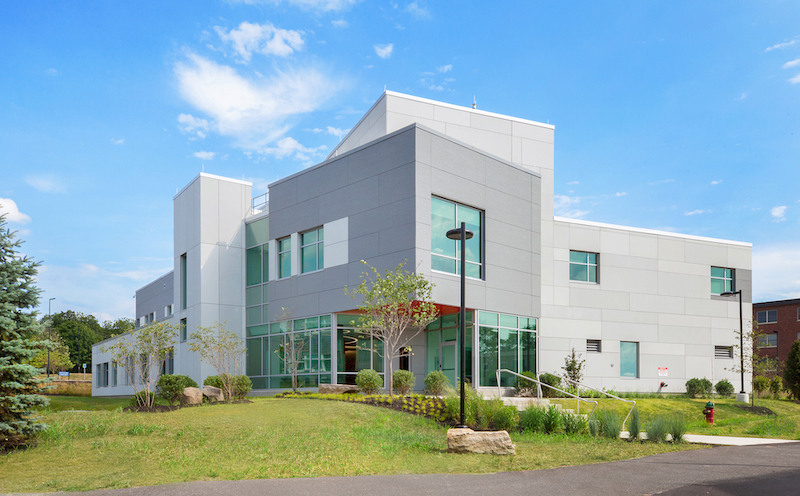The State University of New York (SUNY) at New Paltz’s new Engineering Innovation Hub (EIH) has recently completed construction.
Designed by Urbahn Architects, the two-story EIH was built on a former parking lot on SUNY New Paltz’s main campus. It was designed to allow for a potential expansion to the east if the program requires more space in the future.
The $13.5million, 19,500-sf building houses the College’s bachelor’s degree program in mechanical engineering, teaching and research lab spaces, 3D print prototyping labs, and the school’s Hudson Valley Additive Manufacturing Center (HVAMC).
 Photo by Ola Wilk/Wilk Marketing Communications.
Photo by Ola Wilk/Wilk Marketing Communications.
The HVAMC’s collection of 3D printers are some of the most advanced technology at any academic laboratory in the United States, according to the university. SUNY is the first institution of higher education in the country to be designated a Stratasys-MakerBot Additive Research & Teaching (or SMART) lab by Stratasys, a 3D printing hardware and systems company.
See Also: St. Louis Community College Center for Nursing and Health Sciences opens to students
 Photo by Ola Wilk/Wilk Marketing Communications.
Photo by Ola Wilk/Wilk Marketing Communications.
The building welcomes students via a 661-sf entrance lobby designed to foster collaboration. It features display cabinets for 3D-printed artifacts, counters with computer charging and data outlets, lounge-style seating, and whiteboards. The building’s first floor also features seating niches within the hallways along the windows that integrate with benches, data access, and charging stations. A 1,900-sf teaching lab includes polished-concrete floors and painted steel columns, beams, and a metal deck ceiling. The HVAMC space is located on the first floor across from the teaching lab. An 850-sf machine shop, mechanical and electrical rooms, and public bathrooms round out the first floor.
 Photo by Ola Wilk/Wilk Marketing Communications.
Photo by Ola Wilk/Wilk Marketing Communications.
The second floor is home to a smaller lounge/collaborative space at the end of its main corridor, eight faculty offices, an open office space, a 300-sf conference room, three research/teaching labs, and a 1,200-sf computer lab.
The EIH is centrally located on the SUNY campus and was designed to meet LEED Silver certification requirements.
Also on the Build Team: PC Construction (gc), Vanderweil Engineers (mechanical and electrical engineer), Leslie E. Robertson Associates (structural engineer) BET Engineering Consultants (civil engineer), and Edgewater Design (landscape designer).
 Photo by Ola Wilk/Wilk Marketing Communications.
Photo by Ola Wilk/Wilk Marketing Communications.
 Photo courtesy of SUNY New Paltz.
Photo courtesy of SUNY New Paltz.
Related Stories
| Jun 12, 2014
Tod Williams Billie Tsien Architects' design selected for new UCSC facility
The planned site is a natural landscape among redwood trees with views over Monterey Bay, a site that the architects have called “one of the most beautiful they have ever worked on.”
| Jun 12, 2014
Austrian university develops 'inflatable' concrete dome method
Constructing a concrete dome is a costly process, but this may change soon. A team from the Vienna University of Technology has developed a method that allows concrete domes to form with the use of air and steel cables instead of expensive, timber supporting structures.
| Jun 11, 2014
5 ways Herman Miller's new office concept rethinks the traditional workplace
Today's technologies allow us to work anywhere. So why come to an office at all? Herman Miller has an answer.
| Jun 9, 2014
6 design strategies for integrating living and learning on campus
Higher education is rapidly evolving. As we use planning and design to help our clients navigate major shifts in culture, technology, and funding, it is essential to focus on strategies that help foster an education that is relevant after graduation. One way to promote relevance is to strengthen the bond between academic disciplines and the campus residential life experience.
| May 29, 2014
7 cost-effective ways to make U.S. infrastructure more resilient
Moving critical elements to higher ground and designing for longer lifespans are just some of the ways cities and governments can make infrastructure more resilient to natural disasters and climate change, writes Richard Cavallaro, President of Skanska USA Civil.
Sponsored | | May 27, 2014
Grim Hall opens the door to fire safety with fire-rated ceramic glass
For the renovation of Lincoln University’s Grim Hall life sciences building into a state-of-the-art computer facility, Tevebaugh Associates worked to provide students and faculty with improved life safety protection. Updating the 1925-era facility's fire-rated doors was an important component of the project.
| May 20, 2014
Kinetic Architecture: New book explores innovations in active façades
The book, co-authored by Arup's Russell Fortmeyer, illustrates the various ways architects, consultants, and engineers approach energy and comfort by manipulating air, water, and light through the layers of passive and active building envelope systems.
| May 19, 2014
What can architects learn from nature’s 3.8 billion years of experience?
In a new report, HOK and Biomimicry 3.8 partnered to study how lessons from the temperate broadleaf forest biome, which houses many of the world’s largest population centers, can inform the design of the built environment.
| May 13, 2014
19 industry groups team to promote resilient planning and building materials
The industry associations, with more than 700,000 members generating almost $1 trillion in GDP, have issued a joint statement on resilience, pushing design and building solutions for disaster mitigation.
| May 11, 2014
Final call for entries: 2014 Giants 300 survey
BD+C's 2014 Giants 300 survey forms are due Wednesday, May 21. Survey results will be published in our July 2014 issue. The annual Giants 300 Report ranks the top AEC firms in commercial construction, by revenue.

















